Discover 11 hidden attractions, cool sights, and unusual things to do in Mamallapuram (India). Don't miss out on these must-see attractions: Pancha Rathas, Shore Temple, and Arjuna's Penance. Also, be sure to include Nakula Sahadeva Ratha in your itinerary.
Below, you can find the list of the most amazing places you should visit in Mamallapuram (Tamil Nadu).
Table of Contents
Pancha Rathas

Historic temples sculpted like chariots. Pancha Rathas is a monument complex at Mahabalipuram, on the Coromandel Coast of the Bay of Bengal, in the Kancheepuram district of the state of Tamil Nadu, India. Pancha Rathas is an example of monolithic Indian rock-cut architecture. The complex was initially thought to have carved during the reign of King Narasimhavarman I However, historians such as Nagaswamy attributed all of monuments in Mahabalipuram to Narasimhavarman II with the discovery of new inscriptions. The complex is under the auspices of the Archaeological Survey of India and is part of the UNESCO World Heritage site inscribed by UNESCO as Group of Monuments at Mahabalipuram.
Each of the five monuments in the Pancha Rathas complex resembles a chariot (ratha), and each is carved over a single, long stone or monolith, of granite which slopes in north–south direction with a slight incline. Though sometimes mistakenly referred to as temples, the structures were never consecrated because they were never completed following the death of Narasimhavarman I. The structures are named after the Pancha Pandavas and their common wife Draupadi, of epic Mahabharata fame. In order of their size, they include the Dharmaraja Ratha, Bhima Ratha, Arjuna Ratha, Nakula Sahadeva Ratha, and Draupadi Ratha.[1]
Address: Kancheepuram District, Mamallapuram
Shore Temple
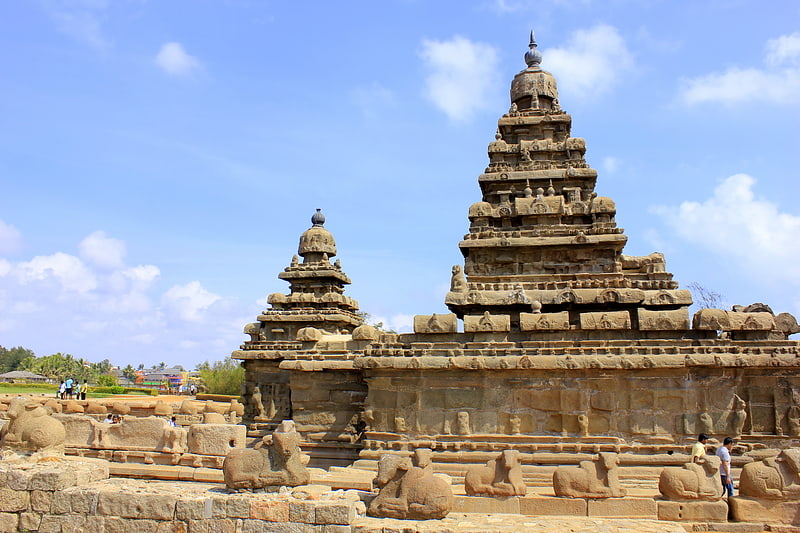
Also known as: महाबलिपुरम के तट मन्दिर
8th-century complex of 3 temples. The Shore Temple is a complex of temples and shrines that overlooks the shore of the Bay of Bengal. It is located in Mahabalipuram, about 60 kilometres south of Chennai in Tamil Nadu, India.
It is a structural temple, built with blocks of granite, dating from the 8th century AD. At the time of its creation, the site was a busy port during the reign of Narasimhavarman II of the Pallava dynasty. As one of the Group of Monuments at Mahabalipuram, it has been classified as a UNESCO World Heritage Site since 1984. It is one of the oldest structural (versus rock-cut) stone temples of South India.[2]
Arjuna's Penance
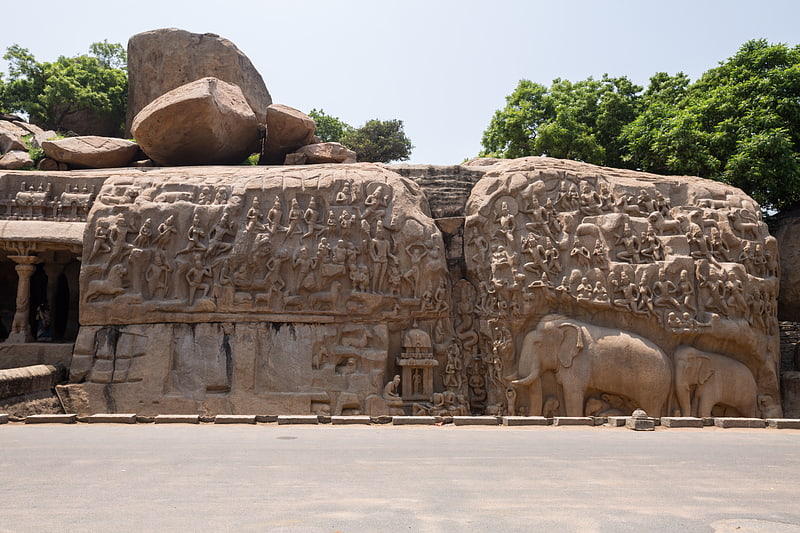
Also known as: गंगावतरण शैल
Descent of the Ganges is a monument at Mamallapuram, on the Coromandel Coast of the Bay of Bengal, in the Chengalpattu district of the state of Tamil Nadu, India. Measuring 96 by 43 feet, it is a giant open-air rock relief carved on two monolithic rock boulders. The legend depicted in the relief is the story of the descent of the sacred river Ganges to earth from the heavens led by Bhagiratha. The waters of the Ganges are believed to possess supernatural powers. The descent of the Ganges and Arjuna's Penance are portrayed in stone at the Pallava heritage site. The relief is more of a canvas of Indian rock cut sculpture at its best not seen anywhere in India. It is one of the Group of Monuments at Mamallapuram that were designated as a UNESCO World Heritage Site since 1984.[3]
Address: West Raja Street, 603104 Mahabalipuram
Nakula Sahadeva Ratha
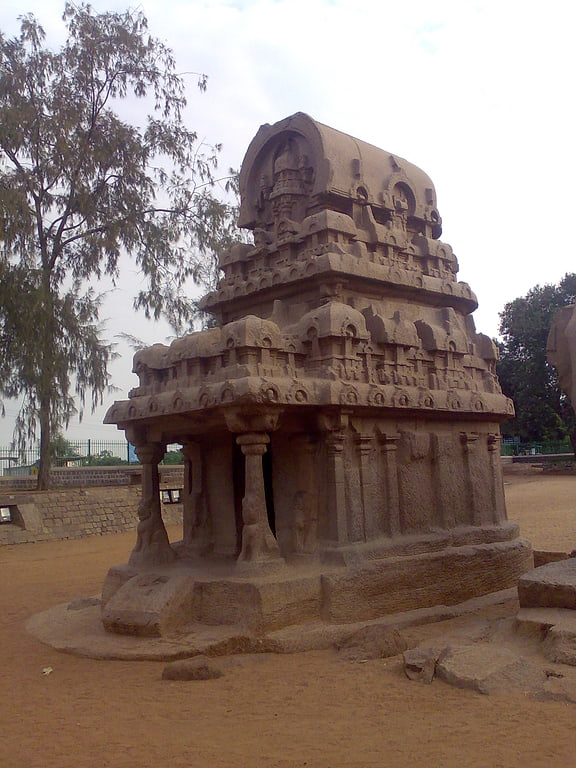
Nakula Sahadeva Ratha is a monument in the Pancha Rathas complex at Mahabalipuram, on the Coromandel Coast of the Bay of Bengal, in the Kancheepuram district of the state of Tamil Nadu, India. It is an example of monolith Indian rock-cut architecture. Dating from the late 7th century, it is attributed to the reign of King Mahendravarman I and his son Narasimhavarman I of the Pallava Kingdom. The entire complex is under the auspices of the Archaeological Survey of India, and is one of the Group of Monuments at Mahabalipuram that were designated as a UNESCO World Heritage Site since 1984.
Resembling a chariot (ratha), it is carved out of a single, long stone of pink granite. Though sometimes mistakenly referred to as a temple, the structure was not consecrated because it was not completed following the death of Narasimhavarman I. The structure is named after the last two brothers of the Pancha Pandavas, of epic Mahabharata fame, though the nomenclature is not supported by history. The small unfinished structure is dedicated to the god Indra.[4]
Mahabalipuram lighthouse
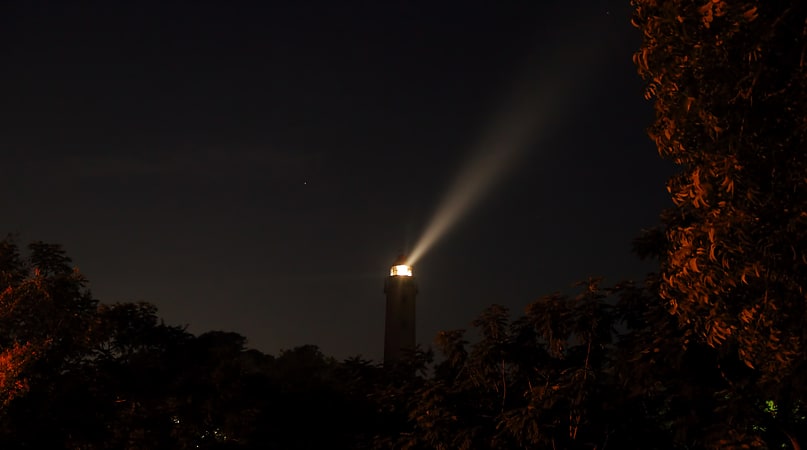
Lighthouse in Mahabalipuram, India. Mahabalipuram Lighthouse is located in Tamil Nadu, India. It has been open to tourists since 2011. It was closed in 2001 following a perceived threat from the Liberation Tigers of Tamil Eelam. The first light was commissioned here in 1887. The lighthouse, with a circular masonry tower made of natural stone, became fully functional in 1904. India's oldest lighthouse, built around 640 AD by Pallava king Mahendravarman I stands next to this modern structure. The Pallava era lighthouse is a protected monument, maintained by the Archaeological Survey of India.[5]
Krishna's Butterball
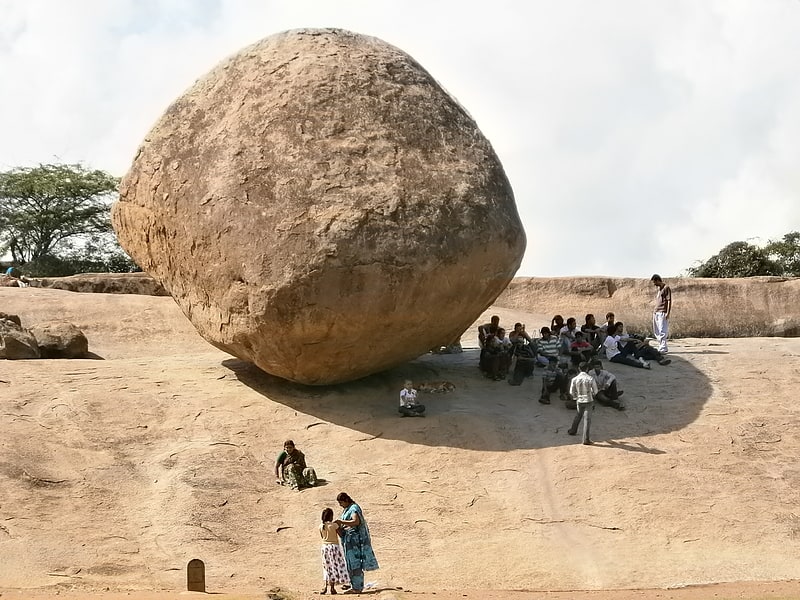
Tourist attraction in Mahabalipuram, India. Krishna's Butterball is a gigantic granite boulder resting on a short incline in the historical coastal resort town of Mamallapuram in Tamil Nadu state of India.
Being part of the Group of Monuments at Mamallapuram, a UNESCO World Heritage Site built during the seventh- and eighth-century CE as Hindu religious monuments by the Pallava dynasty, it is a popular tourist attraction. It is listed as a protected national monument by the Archeological Survey of India.[6]
Address: E Raja St, 603104 Mahabalipuram
Thirukadalmallai

Sthalasayana Perumal Temple is at Mahabalipuram. Constructed in the Dravidian style of architecture, the temple is glorified in the Divya Prabandha, the early medieval Tamil canon of the Azhwar saints from the 6th–9th centuries AD. It is one of the 108 Divyadesam dedicated to Vishnu, who is worshipped as Sthalasayana Perumal and his consort Lakshmi as Nilamangai Thayar. The temple is believed to have been built by Pallavas, with later contributions from Medieval Cholas, Vijayanagar kings and Madurai Nayaks.
The temple is believed to be the birthplace of the Vaishnava Azhwar saint Bhoothathalvar. Sthalasayana Perumal is believed to have appeared to sage Pundarika. The temple is open from 6 am to 12 pm and 3pm to 8:30 pm. Six daily rituals and a dozen yearly festivals are held at the temple, of which the Bhoothatazhwar Avata festival, celebrated during the Tamil month of Aipasi (October–November) being the most prominent. The temple is one of the 32 Group of Monuments at Mahabalipuram that are declared as UN world heritage sites, but unlike others that are maintained by the Archaeological Survey of India, the temple is maintained and administered by the Hindu Religious and Endowment Board of the Government of Tamil Nadu.[7]
Krishna Mandapa

Cave in Mahabalipuram, India. Mahishasuramardhini Mandapa is an example of Indian rock-cut architecture dating from the late 7th century, of the Pallava dynasty. It is a rock-cut cave temple located on a hill, near a lighthouse, along with other caves in Mamallapuram. Mamallapuram, also popularly known as Mahabalipuram, is a small village to the south of Chennai, in the state of Tamil Nadu, India. The temple is part of the Group of Monuments at Mahabalipuram, a UNESCO World Heritage Site inscribed in 1984. This Cave Temple has many interesting architectural features of which three exquisitely carved reliefs on the cave walls of three sanctums are prominent. One is of Vishnu reclining on the seven hooded serpent, Adisesha, another of Durga, the main deity of the cave temple Durga slaying the buffalo headed demon Mahishasura, and the third sanctum also has a sculpture of Shiva.[8]
Ganesh Ratha
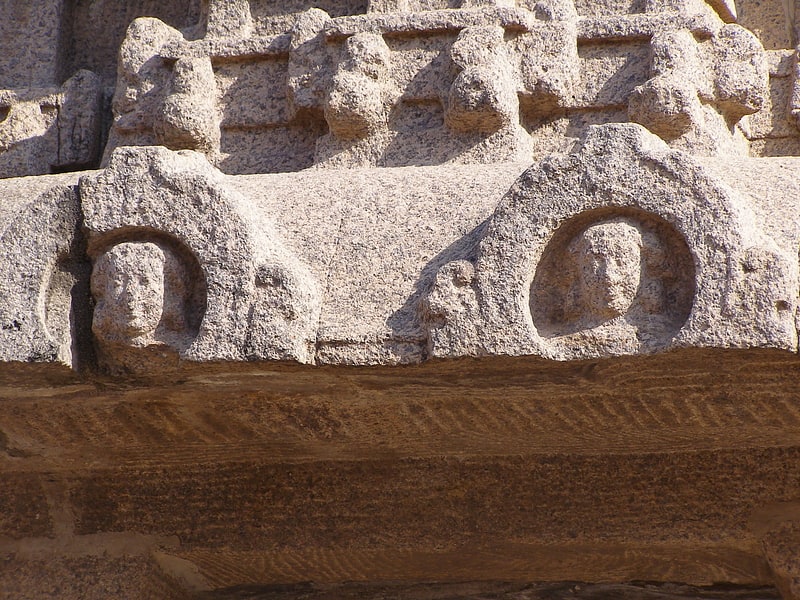
Historical landmark in Mahabalipuram, India. Ganesha Ratha is a temple in Kancheepuram district, Tamil Nadu, India. It is one of ten rathas carved out of pink granite within the group of monuments of the Pallava Period at Mahabalipuram, a UNESCO-inscribed World Heritage Site since 1984. The ratha is an example of monolith Indian rock-cut architecture dating from the late seventh century during the reign of King Mahendravarman I and his son Narasimhavarman I. Initially constructed with a Shiva Linga, it is now deified with a Ganesha deity after the linga was removed.[9]
Address: Mada Koil St, 603104 Mahabalipuram
Dharmaraja Ratha

Dharmaraja Ratha is a monument in the Pancha Rathas complex at Mahabalipuram, on the Coromandel Coast of the Bay of Bengal, in the Kancheepuram district of the state of Tamil Nadu, India. It is an example of monolith Indian rock-cut architecture. Dating from the late 7th century, it is attributed to the reign of King Mahendravarman I and his son Narasimhavarman I of the Pallava Kingdom. The entire complex is under the auspices of the Archaeological Survey of India. It is one of the Group of Monuments at Mahabalipuram that were designated as a UNESCO World Heritage Site since 1984.
Resembling a chariot (ratha), it is carved out of a single, long stone of pink granite. Though sometimes mistakenly referred to as a temple, the structure was not consecrated because it was not completed following the death of Narasimhavarman I. The structure is named after the eldest of the Pancha Pandavas, of epic Mahabharata fame, though this nomenclature is not supported by its iconography. It is dedicated to Shiva.[10]
Group of Monuments at Mahabalipuram

UNESCO-listed stone temple complex. The Group of Monuments at Mahabalipuram is a collection of 7th- and 8th-century CE religious monuments in the coastal resort town of Mahabalipuram, Tamil Nadu, India and a UNESCO World Heritage Site. It is on the Coromandel Coast of the Bay of Bengal, about 60 kilometres south of Chennai.
The site has 40 ancient monuments and Hindu temples, including one of the largest open-air rock reliefs in the world: the Descent of the Ganges or Arjuna's Penance. The group contains several categories of monuments: ratha temples with monolithic processional chariots, built between 630 and 668; mandapa viharas (cave temples) with narratives from the Mahabharata and Shaivic, Shakti and Vaishna inscriptions in a number of Indian languages and scripts; rock reliefs (particularly bas-reliefs); stone-cut temples built between 695 and 722, and archaeological excavations dated to the 6th century and earlier.
The monuments were built during the Pallava dynasty. Known as the Seven Pagodas in many colonial-era publications, they are also called the Mamallapuram temples or Mahabalipuram temples in contemporary literature. The site, restored after 1960, has been managed by the Archaeological Survey of India.[11]